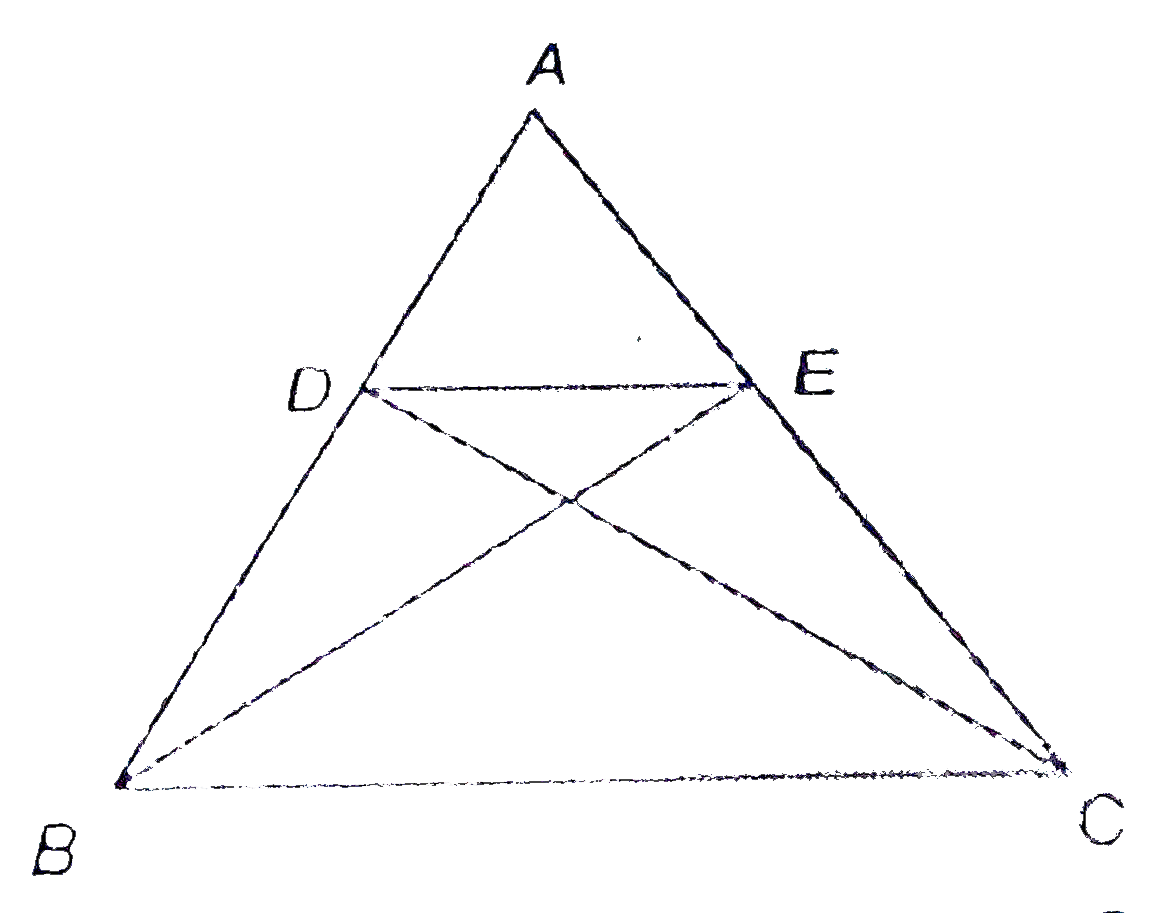Let the incircle of a ΔABC touches sides BC, CA and AB at D,E and F, respectively. Let area of ΔABC be Δ and thatof DEF be Δ'. If a, b and c are side of DetlaABC, then the value of abc(a+b+c)Δ'Δ3 is
1
2
3
4
The correct Answer is:D
To solve the problem, we need to find the value of the expression abc(a+b+c)Δ′Δ3 where Δ is the area of triangle ABC and Δ′ is the area of triangle DEF, which is formed by the points where the incircle of triangle ABC touches the sides.
1. Understanding the Problem:
- We have triangle ABC with sides a,b,c.
- The incircle touches sides BC,CA,AB at points D,E,F respectively.
- The area of triangle ABC is denoted as Δ and the area of triangle DEF as Δ′.
2. Using the Area of Triangle DEF:
- The area Δ′ of triangle DEF can be expressed in terms of the inradius r and the angles of triangle ABC:
Δ′=2r2⋅sin(A2)sin(B2)sin(C2)
- Here, r is the inradius of triangle ABC.
3. Finding the Semi-Perimeter:
- The semi-perimeter s of triangle ABC is given by:
s=a+b+c2
- Therefore, a+b+c=2s.
4. Substituting Values:
- Now substituting a+b+c into our expression:
abc(2s)Δ′Δ3
5. Using Heron's Formula for Area:
- The area Δ of triangle ABC can be expressed using Heron's formula:
Δ=√s(s−a)(s−b)(s−c)
6. Final Expression:
- Now substituting for Δ′ and Δ into our expression:
abc(2s)(2r2sin(A2)sin(B2)sin(C2))Δ3
7. Simplifying:
- After simplification and substituting known relationships, we find that:
abc(2s)(2r2⋅14R2)Δ3=4
- This leads us to conclude that the value of the expression is 4.
Conclusion:
Thus, the value of abc(a+b+c)Δ′Δ3 is 4.
- We have triangle ABC with sides a,b,c.
- The incircle touches sides BC,CA,AB at points D,E,F respectively.
- The area of triangle ABC is denoted as Δ and the area of triangle DEF as Δ′.
- The area Δ′ of triangle DEF can be expressed in terms of the inradius r and the angles of triangle ABC:
Δ′=2r2⋅sin(A2)sin(B2)sin(C2)
- Here, r is the inradius of triangle ABC.
- The semi-perimeter s of triangle ABC is given by:
s=a+b+c2
- Therefore, a+b+c=2s.
- Now substituting a+b+c into our expression:
abc(2s)Δ′Δ3
- The area Δ of triangle ABC can be expressed using Heron's formula:
Δ=√s(s−a)(s−b)(s−c)
- Now substituting for Δ′ and Δ into our expression:
abc(2s)(2r2sin(A2)sin(B2)sin(C2))Δ3
- After simplification and substituting known relationships, we find that:
abc(2s)(2r2⋅14R2)Δ3=4
- This leads us to conclude that the value of the expression is 4.
Thus, the value of abc(a+b+c)Δ′Δ3 is 4.
Topper's Solved these Questions
- SOLUTIONS AND PROPERTIES OF TRIANGLE BOOK - CENGAGE ENGLISHCHAPTER - SOLUTIONS AND PROPERTIES OF TRIANGLE EXERCISE - Multiple Correct Answers Type
13 Videos
- SOLUTIONS AND PROPERTIES OF TRIANGLE BOOK - CENGAGE ENGLISHCHAPTER - SOLUTIONS AND PROPERTIES OF TRIANGLE EXERCISE - Comprehension Type
6 Videos
- SET THEORY AND REAL NUMBER SYSTEM BOOK - CENGAGE ENGLISHCHAPTER - SET THEORY AND REAL NUMBER SYSTEM EXERCISE - Archives
1 Videos
- STATISTICSBOOK - CENGAGE ENGLISHCHAPTER - STATISTICSEXERCISE - Archives
10 Videos
Similar Questions
The incircle of an isoceles triangle ABC, with AB=AC, touches the sides AB,BC and CA at D,E and F respecrively. Prove that E bisects BC.
View SolutionIf in ΔABC, sides a, b, c are in A.P. then
View SolutionAL, BM and CN are perpendicular from angular points of a triangle ABC on the opposite sides BC, CA and AB respectively. Δ is the area of triangle ABC, (r ) and R are the inradius and circumradius.
If area of ΔLMN is Δ', then the value of Δ'Δ is
View SolutionIn a ΔABC,D,EandF are the mid-point of sides BC, CA and AB respectively. If area of ΔABC=16cm2, find the area of trapezium FBCE
View SolutionD, E and F are the mid-points of the sides BC, CA and AB, respectively of an equilateral ΔABC. Show that ΔDEF is also an equilateral triangle.
View SolutionAL, BM and CN are perpendicular from angular points of a triangle ABC on the opposite sides BC, CA and AB respectively. Δ is the area of triangle ABC, (r ) and R are the inradius and circumradius.
If perimeters of ΔLMNandΔABCanλandμ, then the value of λμ is
View SolutionD, E and F are the mid-points of the sides BC, CA and AB respectively of triangle ABC. Prove that:
area of BDEF is half the area of ΔABC.
View SolutionD, E and F are the mid-points of the sides BC, CA and AB respectively of triangle ABC. Prove that:
BDEF is a parallelogram.
View SolutionIn the adjoning figure, D and E are the points on the sides AB and AC respectively of ΔABC and area of ΔBCE= area of ΔBCD.
Prove that DE∣∣BC

View SolutionIn ΔABC,AB=AC.D,Eand F are mid-points of the sides BC, CA and AB respectively . Show that :
AD and FE bisect each other.
View Solution
